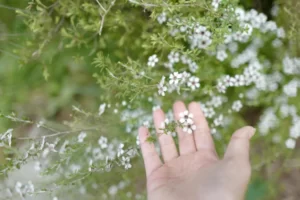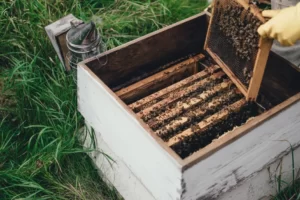Table of Contents
Introduction
In the world of natural remedies, honey has long been recognized for its healing properties. One type of honey that has gained significant attention in recent years is manuka honey. Manuka honey is derived from the nectar of the manuka tree (Leptospermum scoparium) and is known for its unique antibacterial properties. However, there is also a debate about the effectiveness of manuka honey compared to other types of honey, such as multifloral honey. In this article, we will explore the differences between monofloral and multifloral manuka honey and their potential effects on antibiotic-resistant wound-infecting bacteria.
Monofloral Manuka Honey
The Production of Manuka Honey
Manuka honey is produced by bees that collect nectar from the flowers of the manuka tree. The resulting honey has a distinct flavor and aroma, which is often described as earthy, herbaceous, and slightly bitter. The concentration of manuka honey can vary depending on the region and the time of year, as well as other factors such as weather conditions and beekeeping practices.
Antibacterial Properties of Manuka Honey
One of the reasons manuka honey is highly valued is its antibacterial properties. Manuka honey contains natural compounds, such as methylglyoxal (MGO), dihydroxyacetone (DHA), and hydrogen peroxide, which have been found to inhibit the growth of bacteria. These compounds are believed to work together to create a synergistic effect, making manuka honey a potent antibacterial agent. The level of antibacterial activity in manuka honey is often measured using the Unique Manuka Factor (UMF), which indicates the concentration of MGO in the honey.
Scientific Studies on Monofloral Manuka Honey
Several scientific studies have been conducted to evaluate the antibacterial efficacy of monofloral manuka honey. In a study published in the Journal of Antimicrobial Chemotherapy, researchers tested the activity of various honey samples against antibiotic-resistant bacteria, including Acinetobacter baumannii, Staphylococcus aureus, Pseudomonas aeruginosa, and Escherichia coli. The study found that manuka honey had significant antibacterial activity against these bacteria, even at low concentrations.
Another study published in Frontiers in Microbiology investigated the antibiofilm effects of manuka honey on MRSA and VRE biofilms. The researchers found that manuka honey was able to inhibit the formation and growth of biofilms, which are communities of bacteria that can form on surfaces and contribute to the development of chronic wounds.
Multifloral Manuka Honey
What is Multifloral Manuka Honey?
Multifloral manuka honey, also known as polyfloral or blended manuka honey, is produced by bees that collect nectar from a variety of plant sources, including manuka trees and other flowering plants. Unlike monofloral manuka honey, which is derived solely from the nectar of manuka trees, multifloral manuka honey is a combination of nectars from different plants.
Antibacterial Properties of Multifloral Manuka Honey
Although multifloral manuka honey may not have the same concentration of MGO as monofloral manuka honey, it still possesses antibacterial properties. The combination of different plant nectars in multifloral honey can contribute to its antimicrobial activity. Additionally, multifloral manuka honey may contain other bioactive compounds that have antibacterial effects.
Scientific Studies on Multifloral Manuka Honey
While there is limited research specifically on multifloral manuka honey, studies have shown that multifloral honey in general has antibacterial properties. A study published in the Journal of Applied Microbiology investigated the antimicrobial activity of various honey samples, including multifloral honey, against a range of bacteria. The study found that multifloral honey had significant antimicrobial activity against the tested bacteria, including S. aureus, Escherichia coli, and Pseudomonas aeruginosa.
Conclusion
In conclusion, both monofloral and multifloral manuka honey have been found to inhibit the growth of antibiotic-resistant wound-infecting bacteria. Monofloral manuka honey, with its high concentration of bioactive compounds, may have a more potent antibacterial effect. However, multifloral manuka honey, with its combination of nectars from different plants, also possesses antibacterial properties. Regardless of the type of manuka honey used, it is clear that honey, in general, can be an effective natural remedy for wound infections. Further research is needed to better understand the optimal use of manuka honey in wound care and to explore its potential applications in other areas of medicine.
External References:
- Hewett, S.R.; Crabtrey, S.D.; Dodson, E.E.; Rieth, C.A.; Tarkka, R.M.; Naylor, K. Both Manuka and Non-Manuka Honey Types Inhibit Antibiotic Resistant Wound-Infecting Bacteria. Antibiotics, 2022, 11(8), 1132.
- Magill, S.S.; Edwards, J.R.; Bamberg, W.; Beldavs, Z.G.; Dumyati, G.; Kainer, M.A.; Lynfield, R.; Maloney, M.; McAllister-Hollod, L.; Nadle, J.; et al. Multistate Point-Prevalence Survey of Health Care–Associated Infections. N. Engl. J. Med. 2014, 370, 1198–1208.
- Weiner, L.M.; Webb, A.K.; Limbago, B.; Dudeck, M.A.; Patel, J.; Kallen, A.J.; Edwards, J.R.; Sievert, D.M. Antimicrobial-Resistant Pathogens Associated With Healthcare-Associated Infections: Summary of Data Reported to the National Healthcare Safety Network at the Centers for Disease Control and Prevention, 2011–2014. Infect. Control Hosp. Epidemiol. 2016, 37, 1288–1301.
- Molan, P. Honey: Antimicrobial Actions and Role in Disease Management. In Honey: A Comprehensive Survey; John Wiley & Sons, Ltd.: Hoboken, NJ, USA, 2008; pp. 229–253.
- Hussain, M.B. Role of Honey in Topical and Systemic Bacterial Infections. Altern. Complement. Med. 2018, 24, 15–24.
- Tinsley, J. The Production of Honey. Bee World 1980, 61, 95–98.
- Crane, E. Honey: A Comprehensive Survey; Heinemann [for] the Bee Research Association: London, UK, 1975; pp. 157–206.
- Brudzynski, K.; Abubaker, K.; St-Martin, L.; Castle, A. Re-Examining the Role of Hydrogen Peroxide in Bacteriostatic and Bactericidal Activities of Honey. Front. Microbiol. 2011, 2, 213.
- Linley, E.; Denyer, S.P.; McDonnell, G.; Simons, C.; Maillard, J.-Y. Use of Hydrogen Peroxide as a Biocide: New Consideration of Its Mechanisms of Biocidal Action. Sci. Rep. 2017, 7, 43360.
- Mandal, M.D.; Mandal, S. Honey: Its Medicinal Property and Antibacterial Activity. Asian Pac. J. Trop. Biomed. 2011, 1, 154–160.
- Molan, P.; Rhodes, T. Honey: A Biologic Wound Dressing. Wounds 2015, 27, 141–151.
- Brudzynski, K.; Lannigan, R. Mechanism of Honey Bacteriostatic Action Against MRSA and VRE Involves Hydroxyl Radicals Generated from Honey’s Hydrogen Peroxide. Front. Microbiol. 2012, 3, 36.
- Brackman, G.; De Meyer, L.; Nelis, H.J.; Coenye, T. Biofilm Inhibitory and Eradicating Activity of Wound Care Products against Staphylococcus Aureus and Staphylococcus Epidermidis Biofilms in an in Vitro Chronic Wound Model. J. Antimicrob. Chemother. 2013, 68, 1833–1842.
- Majtan, J.; Bohova, J.; Horniackova, M.; Klaudiny, J.; Majtan, V. Anti-Biofilm Effects of Honey against Wound Pathogens Proteus Mirabilis and Enterobacter Cloacae. J. Appl. Microbiol. 2014, 117, 69–75.
- Lee, J.-H.; Park, J.-H.; Kim, J.-A.; Neupane, G.P.; Cho, M.H.; Lee, C.-S.; Lee, J. Low Concentrations of Honey Reduce Biofilm Formation, Quorum Sensing, and Virulence in Escherichia Coli O157:H7. Front. Microbiol. 2017, 8, 2467.
- Truchado, P.; López-Gálvez, F.; Gil, M.I.; Tomás-Barberán, F.A.; Allende, A. Quorum Sensing Inhibitory and Antimicrobial Activities of Honeys and the Relationship with Individual Phenolics. Food Chem. 2009, 115, 1337–1344.
- Wang, R.; Starkey, M.; Hazan, R.; Rahme, L.G. Honey’s Ability to Counter Bacterial Infections Arises from Both Bactericidal Compounds and QS Inhibition. Front. Microbiol. 2012, 3, 144.
- Robson, V.; Dodd, S.; Thomas, S. Standardized Antibacterial Honey (Medihoney) with Standard Therapy in Wound Care: Randomized Clinical Trial. J. Antimicrob. Chemother. 2009, 63, 565–575.
- Lusby, P.E.; Coombes, A.L.; Wilkinson, J.M. Bactericidal Activity of Different Honeys against Pathogenic Bacteria. Arch. Med. Res. 2005, 36, 464–467.
- Molan, P. An Explanation of Why the MGO Level in Manuka Honey Does Not Show the Antibacterial Activity. npj Biofilms Microbiomes 2016, 2, 16102.
- Bucekova, M.; Sojka, M.; Valachova, I.; Martinotti, S.; Ranzato, E.; Szep, Z.; Majtan, V.; Klaudiny, J.; Majtan, J. Bee-Derived Antibacterial Peptide, Defensin-1, Promotes Wound Reepithelialisation in Vitro and in Vivo. Mediators Inflamm. 2017, 2017, 7340385.
- WHO Publishes List of Bacteria for Which New Antibiotics Are Urgently Needed. Available online: https://www.who.int/news/item/27-02-2017-who-publishes-list-of-bacteria-for-which-new-antibiotics-are-urgently-needed (accessed on 25 July 2022).
- National Honey Board Honey: A Reference Guide to Nature’s Sweetener. Available online: https://www.honey.com/national-honey-board/research-and-education/honey-a-reference-guide-to-natures-sweetener (accessed on 26 July 2022).
- Roshan, N.; Rippers, T.; Locher, C.; Hammer, K.A. Antibacterial Activity and Chemical Characteristics of Several Western Australian Honeys Compared to Manuka Honey and Pasture Honey. Foods 2022, 11, 347–355.
- Anand, S.; Pang, E.; Livanos, G.; Mantri, N. Characterization of Physico-Chemical Properties and Antioxidant Capacities of Bioactive Honey Produced from Australian Grown Agastache Rugosa and Its Correlation with Colour and Poly-Phenol Content. Int. J. Environ. Res. Public Health 2022, 19, 108.
- Brudzynski, K.; Adubaker, K.; Miotto, D. Unraveling a Mechanism of Honey Antibacterial Action: Polyphenol/H2O2-Induced Oxidative Effect on Bacterial Cell Growth and on DNA Degradation. Food Chem. 2020, 329, 127173.
- Grainger, M.N.C.; Manley-Harris, M.; Lane, J.R.; Field, R.J. Kinetics of Conversion of Dihydroxyacetone to Methylglyoxal in New Zealand Mānuka Honey: Part I—Honey Systems. Food Chem. 2020, 316, 126329.
- Liu, M.Y.; Cokcetin, N.N.; Lu, J.; Turnbull, L.; Carter, D.A.; Whitchurch, C.B.; Harry, E.J. Rifampicin-Manuka Honey Combinations Are Superior to Other Antibiotic-Manuka Honey Combinations in Eradicating Staphylococcus Aureus Biofilms. Front. Microbiol. 2018, 9, 2541.
- Soffer, L. Arkansas Native Wildflowers. Available online: https://files.uaex.edu/publications/pdf/May%2022%202017%20Florida%20beekeepers%20attend%20Station%20Field%20Day.pdf (accessed on 26 July 2022).
- USDA. Plants Database. Available online: https://plants.sc.egov.usda.gov/java/ (accessed on 11 July 2022).
- CDC. 2016 HAI Progress Report. Available online: https://www.cdc.gov/hai/progress-report/index.html (accessed on 13 July 2022).
- HAI|CDC. Acinetobacter in Healthcare Settings. Available online: https://www.cdc.gov/HAI/organisms/acinetobacter.html (accessed on 13 July 2022).
- Klevens, R.M.; Edwards, J.R.; Richards, C.L.; Horan, T.C.; Gaynes, R.P.; Pollock, D.A.; Cardo, D.M. Estimating Health Care-Associated Infections and Deaths in U.S. Hospitals, 2002. Public Health Rep. 2007, 122, 160–166.
- CDC. What CDC Is Doing: Antibiotic Resistance (AR) Solutions Initiative. Available online: https://www.cdc.gov/DrugResistance/solutions-initiative/index.html (accessed on 13 July 2022).
- Jenkins, R.; Burton, N.; Cooper, R. Proteomic and Genomic Analysis of Methicillin-Resistant Staphylococcus Aureus (MRSA) Exposed to Manuka Honey in Vitro Demonstrated down-Regulation of Virulence Markers. J. Antimicrob. Chemother. 2014, 69, 603–615.
- Molan, P. The Evidence and the Rationale for the Use of Honey as a Wound Dressing. Wounds 2020, 32, 204–220.
- Aamer, A.A.; Abdul-Hafeez, M.M.; Sayed, S.M. Minimum Inhibitory and Bactericidal Concentrations (MIC and MBC) of Honey and Bee Propolis against Multi-Drug Resistant (MDR) Staphylococcus Sp. Isolated from Bovine Clinical Mastitis. Altern. Integr. Med. 2014, 3, 4.
- Cooper, R.A.; Jenkins, L.; Henriques, A.F.M.; Duggan, R.S.; Burton, N.F. Absence of Bacterial Resistance to Medical-Grade Manuka Honey. Eur. J. Clin. Microbiol. Infect. Dis. 2010, 29, 1237–1241.
- Chris, D. New Klebsiella Strains “Worst-Case Scenario,” Experts Say. 2017. Available online: https://www.webmd.com/news/19991020/new-klebsiella-strains-worst-case-scenario-experts-say (accessed on 11 July 2022).
- Bogdanov, S. Harmonised Methods of the International Honey Commission. Available online: https://www.bee-hexagon.net/fileadmin/user_upload/microsites/melissopalynologie.org/Honey-International_2.pdf (accessed on 25 July 2022).
- Beretta, G.; Granata, P.; Farrero, M.; Orioli, M.; Facino, R.M. Standardization of Antioxidant Properties of Honey by a Combination of Spectrophotometric/Fluorimetric Assays and Chemometrics. Anal. Chim. Acta 2005, 533, 185–191.
- Hewett, S.R. Both Manuka and Non-Manuka Honey Types Inhibit Antibiotic Resistant Wound-Infecting Bacteria. Master’s Thesis, University of Central Arkansas, Conway, AR, USA, 2019.



